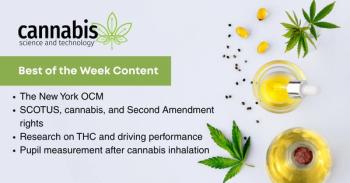
- March/April 2022
- Volume 3
- Issue 1
- Pages: 26-28
Read the Research: What One Medical Writer Can Tell Us from Years of Compiling Data on Medical Cannabis Use for Chronic Pain Treatment, Opioid Addiction Management, and Enhancing Mindfulness
Dr. Uwe Blesching provides insight into the exploration of cannabis as a supplement for chronic pain treatment, opioid addiction mitigation, and the mind-body balance.
Medical writer, author of three books on medical cannabis, and co-founder/chief science officer of CannaKeys, Dr. Uwe Blesching provides insight into the exploration of cannabis as a supplement for chronic pain treatment, opioid addiction mitigation, and the mind-body balance. Informed by his years-long compilation of research and personal experience, he also offers suggestions regarding the challenges and benefits patients and doctors could encounter in their own journey into cannabis research and understanding.
The Potential of Cannabis as a Treatment
Dr. Uwe Blesching started a 20 year long career as a paramedic and fireman for the San Francisco Department of Public Health during the height of the human immunodeficiency virus (HIV) and acquired immunodeficiency syndrome (AIDS) epidemic. He quickly noticed a large patient population that used cannabis for various medical reasons. “It really started with observing and witnessing patients firsthand in the back of my ambulance,” he said.
He explained that initially he was naïve about drugs, particularly cannabis. “I began to notice differences between, let’s say, a person that was challenged by HIV and AIDS, for example, who presented with peripheral neuropathies and who utilized cannabis and those who didn’t,” he said. “The difference between patient presentation and the way they presented themselves, in the larger context, was quite dramatic.”
Dr. Blesching also witnessed patients using medical cannabis who were experiencing chemotherapy-induced nausea and vomiting, or the pains from radiation treatments for specific types of cancer, or even people who were heroin users and who utilized cannabis to mitigate their withdrawal symptoms. “Fairly quickly, I began to look at cannabis and not so much with the black and white perspective that came from the narrative on the war on drugs that I was raised with,” he said. “It added nuance and it added a sense of curiosity to what’s going on here truly.”
During this time, he was also in touch with several physicians who were looking into and trying new treatments, such as cannabis, for HIV. This led him to find “a dozen or so researchers and physicians who were open to looking at cannabis and who were the pioneers in a lot of the research that has since transpired over the past 30 years or so.” He felt that this environment “was a welcoming of kindred spirits opening their minds,” but the stigma that came from the war on drugs hampered progress. “In general, the medical community like myself, initially, are socialized by the narrative on the war on drugs and as such, if we’re not completely averse to it, we’re very skeptical,” Dr. Blesching explained.
The amount of research conducted in the past 30 years has greatly increased, though, and continues to do so. “To give you a couple of numbers, last year, nearly 4000 studies related to cannabis and specific patient populations were published, which translates to roughly about 10 trials being published on a daily basis that can be utilized to learn more about if cannabis is posited to work for a particular condition or not,” he added.
Compiling the Research and Data
Adding to his firsthand experience with patients, Dr. Blesching’s friends and relatives began to ask his opinion on cannabis as an effective treatment for various ailments such as chronic pain, glaucoma, or high blood pressure. Eager to help and to provide an informed opinion, he began researching and taking down notes, and was surprised to find how many studies had been conducted on cannabis as treatment for chronic pain. Over time those notes became a collection and compilation that turned into his first book, The Cannabis Health Index, and later its online equivalent, CannaKeys (1,2). “The Cannabis Health Index looks at the state of the science for about a hundred different conditions with the question in mind such as, does cannabis work for this particular condition or not? And if it is posited to work, what type of cannabis is thought to work best,” noted Dr. Blesching.
The first edition of The Cannabis Health Index, published in 2015, contained 100 chronic condition and by the third edition, published in March 2022, grew to contain more than 200 conditions. Over time, Dr. Blesching explained, some initial skepticism about cannabis has given way in part “because of the sheer volume of endocannabinoid-related studies that have really laid the groundwork of a new field of science, the cannabinoid health sciences, or endocannabinology as some people refer to it.”
By the time the third edition was started, Dr. Blesching realized that because of the number of new studies, it became imperative to have an electronic version, which is what led to the creation of CannaKeys, so that people who need the very latest research can have access to it. The written and online versions of the studies and data provide a balance for those who need the most updated information and those who need written material. According to Dr. Blesching, the purpose of CannaKeys, which has been created over the past four years, is to “demystify the science of the endocannabinoid system and to make that science available for patients, caretakers, and physicians alike to make this process as streamlined, easy, and elegant as possible.” Rather than having to wade through tens of thousands of unfiltered studies, a significant obstacle that researchers and doctors face, the online databank distills the data into what is useful and relevant in a practical way. This allows users to access a solid foundation on which to make more informed decisions.
Both the book and the online databank contain annotated information and synopses of the most important elements of the texts while also providing the opportunity to access the science itself if a user wanted to perform their own deep dive of the material. Dr. Blesching noted that even with this intentional organization of the material, “we’re very careful to not inject bias or our subjective opinions into the process of making the research as easily digestible in the clinical setting as possible.” While the printed book and the online material are accessible for both doctors and patients, a more patient-focused version of the information is in progress to make the information easier to digest. For now, the online version has accessibility options such as a glossary so that users can learn unfamiliar terms and be prepared to see it in later research.
Cannabis as Pain Management Supplement, Withdrawal Symptom Mitigation, and its Therapeutic Benefits
One major takeaway from his research that Dr. Blesching would like doctors to understand is not to be afraid of looking at cannabinoid-based therapeutics as a potential treatment, especially for the chronic pain patient population. “Look at the data, look at the state of the science and reach out to other cannabis educated physicians and try to learn from their experience because many times they have very specific answers that are relevant to very specific patient populations that may not even be reflected in the science because the state of the science hasn’t caught up to it yet,” he said.
He further explained that most meta-analyses on cannabis studies suggest that cannabis or cannabinoid-based therapeutics absolutely present a valid and viable option in the treatment of chronic pain. “Now, that doesn’t mean that it is a cure-all for chronic pain. There’s a lot of individual circumstances that need to be taken into account,” he added. “But the data is out there for many chronic pain populations, and the science clearly leans in favor of utilizing cannabis for these patient populations.”
Similarly, on the patient side, he suggested that when patients are looking for treatment options, such as for chronic pain, they should make an informed choice about what type of cannabis, what form, and what dosage to use for their situation. “Patients can do this with two goals in mind: first, to mitigate any potential adverse effects and second, to maximize the therapeutic impact that can be possible to mitigate the chronic pain that they’re dealing with,” he said. “If you’re open to it, look at the potential mind-body component of any chronic pain and see if you can widen the net to catch positive therapeutic effects that are not just based on taking a remedy, but taking a broader, wider regimen into account. I found that those folks that do that tend to have their healing experience go broader and go deeper and longer lasting, all the while having to use less and less of whatever physical substances they rely on.”
Dr. Blesching’s second book, Breaking the Cycle of Opioid Addiction, grew out of a desire to understand the deeper context of utilizing cannabinoid-based therapeutics to reduce opioid use. From his research, he has seen a pattern or “map” emerge when patients utilize cannabis to manage withdrawal symptoms. He explained that as patients inhale the concentrated tetrahydrocannabinol (THC), within a minute or so you can see the effects on the withdrawal symptoms. “This makes a big dent in what otherwise would trigger a relapse into using heroin or opioids because of the cannabis concentrate’s capacity to mitigate the withdrawal symptoms,” he said. “However, the idea here is not to replace one substance with another and overly rely on a THC concentrate to mitigate withdrawal symptoms.”
He explained that the goal is instead to eventually reduce cannabis reliance and use, potentially with the help of additional therapeutics and lifestyle changes. “Ultimately we want to find the internal resources that you need in order to deal with the stress or the pain, no matter if it was physical, mental, or emotional, that led you on the path of seeking the care of a strong opioid in the first place,” he said. “The resolution of the underlying components of the maintaining cause is always part and parcel of a patient reaching for not just treatment, but actually for a cure.”
Dr. Blesching describes the therapeutic cannabis experience as an essential part of the mindfulness or mind-body medicine domain. “Number one, it will induce a deep sense of relaxation, not just in the body’s physiology, but also in the mind. Secondly, it will produce a sense of homeostasis, or balance,” he explained. “That is true for every single organ system because cannabis functions systemically. It’s not just one organ system that’s affected by it, but it’s all 11 of them. Next, the therapeutic cannabis experience will give you a gentle uplift in your mood.”
Dr. Blesching likened this experience to other cognitive therapies such as yoga and tai chi, stating that cannabis can be a significant part of the healing process. Additionally, cannabis can also give you a sense of flow. “Flow is a term that’s been utilized a lot to describe when you are in the zone, which is especially important when treating mood disorders because the therapeutic cannabis experience allows you to be in the presence of otherwise intolerable emotional experiences,” he added.
Creating Open Communication Between Doctors and Patients
Despite the vast amounts of studies conducted, according to Dr. Blesching, depending on who you are talking to, research and data about cannabis as a treatment may or may not be immediately accepted. However, Dr. Blesching explained, though some doctors may be hesitant to recommend cannabis for a patient, the more patients bring their questions and anecdotes, the more a responsible doctor may be inclined to investigate the research. Considering that, he suggested that doctors “suspend the negative impact of the narrative on the on war of drugs long enough to let it be possible that you have at your fingertips a potential remedy that, given responsibly, can make a night and day difference in the very patient that you’re dealing with.”
Dr. Blesching suggested that for doctors and patients to be in communication with each other about all treatment options, it helps to be on the same page, literally. “You utilize the same book, utilize the same online research. If there’s one study that you found that speaks to you, share that study with your physician. Or if the physician has a particular set of data that they may make their informed decisions on, share them with your patient,” he said.
He noted that resources like The Cannabis Health Index and CannaKeys are helpful as shared information sources in this regard. For patients who are hesitant to share their cannabis use with their doctor for stigma reasons, Dr. Blesching encouraged them to try to find a cannabis educated physician. “I wouldn’t necessarily stop seeing the physician that you’re seeing now, especially if they have other treatments for you that are working,” he said. “But consider a supplement, adding a physician to your advisory board who is educated about cannabis and take his considerations into account in your decision-making process.”
Looking Forward
To help rethink cannabis use and remove the stigma, Dr. Blesching’s best advice to the medical community and public is to read the research. “There are literally tens of thousands of studies, including clinical trials that clearly indicate that cannabis can work for a great number of different patient populations. Let the data speak for itself and let the scientific method inform the decision process, rather than the biased and uninformed narrative from the war on drugs,” he said.
In looking toward the future to overcoming barriers to accessing medical cannabis, he believes that ultimately the solution is at the federal level. “I think the shift is coming. I think it’s perhaps closer than we think,” Dr. Blesching concluded.
References
- U. Blesching, The Cannabis Health Index: Combining the Science of Medical Marijuana with Mindfulness Techniques to Treat Over 200 Chronic Diseases (Logos Publishing, Berkeley, California, 2022).
https://cannakeys.com/ .
Articles in this issue
over 3 years ago
March/April 2022 Digital Editionover 3 years ago
Chronic Pain: Data Snapshotover 3 years ago
Overview of Research on Cannabis for Chronic Painover 3 years ago
Finding Relief with Cannabisover 3 years ago
Eyewitness: Cannabis Should Be the Chronic Pain Treatment Choiceover 3 years ago
Chronic Pain Advocacy: It’s Time to Testify!Newsletter
Unlock the latest breakthroughs in cannabis science—subscribe now to get expert insights, research, and industry updates delivered to your inbox.





